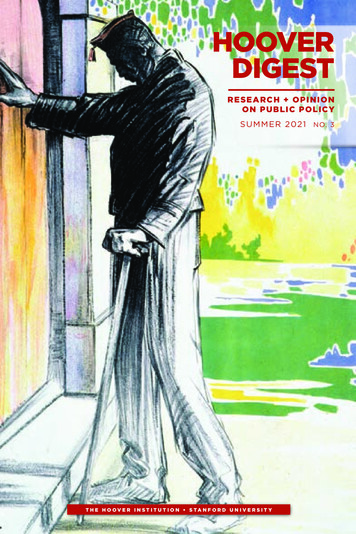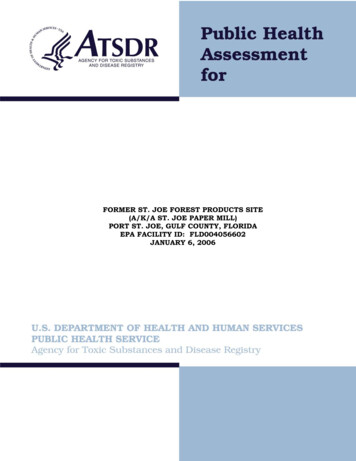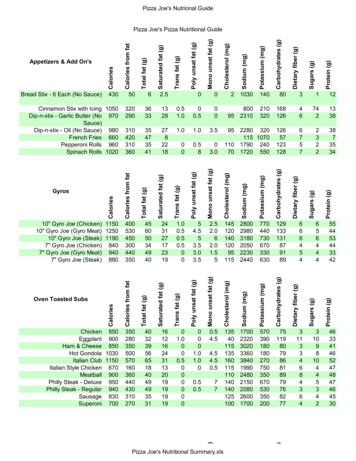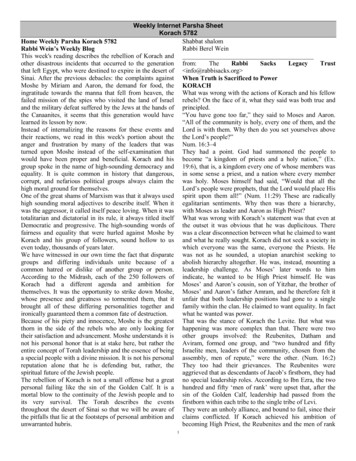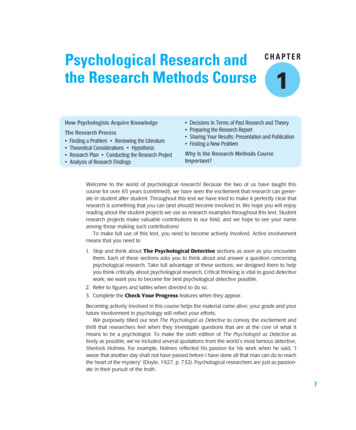
Transcription
Psychological MethodsThe Big, the Bad, and the Ugly: Geographic EstimationWith Flawed Psychological DataJoe Hoover and Morteza DehghaniOnline First Publication, October 24, 2019. , J., & Dehghani, M. (2019, October 24). The Big, the Bad, and the Ugly: GeographicEstimation With Flawed Psychological Data. Psychological Methods. Advance online publication.http://dx.doi.org/10.1037/met0000240
Psychological Methods 2019 American Psychological AssociationISSN: 1082-989X2019, Vol. 1, No. 999, 000http://dx.doi.org/10.1037/met0000240The Big, the Bad, and the Ugly: Geographic Estimation With FlawedPsychological DataJoe Hoover and Morteza DehghaniThis document is copyrighted by the American Psychological Association or one of its allied publishers.This article is intended solely for the personal use of the individual user and is not to be disseminated broadly.University of Southern CaliforniaAbstractThe geographic distribution of psychological constructs has long been an area of focus for psychologicalresearchers. Recently, however, there has been increased interest in investigations of the so-calledsubnational distribution of psychological variables, which focus on localized groupings of individualswithin spatial units, such as counties or states. By estimating the subnational distribution of a givenoutcome (e.g., estimating its state- or county-level means), researchers have been able to addressquestions about the spatial variation of a variety of psychological constructs and investigate the regionalassociation between psychological phenomena and real-world outcomes, such as health outcomes,prosocial behavior, and racial inequity. Unfortunately, however, there are many challenges to estimatinga construct’s subnational distribution, such as those raised by response biases and subnational sparsity.To help psychological researchers address these issues, we provide a comprehensive discussion ofsubnational estimation and introduce multilevel regression and poststratification (MrP), a method that iswidely considered to be the gold standard for subnational estimation with random samples. As psychologists often do not have access to large, national random samples, we also report 3 studies evaluatingMrP’s performance under simulated and real-world conditions of sample biases. Ultimately, we find thatMrP is likely to outperform the subnational estimation methods that psychological researchers currentlyuse. Based on this, we suggest that psychologists interested in understanding how psychologicalphenomena vary below the nation level use MrP to conduct these investigations. To help facilitate this,we have made all code and data used for the reported studies publicly available.Translational AbstractThe geographic distribution of psychological constructs has attracted increasing interest among psychological researchers. Relying on these and other data, psychologists have been able to not only addressnovel questions about the spatial variation of psychological constructs but also investigate the regionalassociation between psychological phenomena and real-world outcomes, such as outcomes associatedwith health, prosocial behavior, and racial inequity. Unfortunately, there are many challenges toestimating a construct’s regional distribution—so-called subnational estimation—and these challengesare exacerbated by issues of nonrepresentativeness and geographic sparsity. In this work, we provide acomprehensive discussion of major obstacles for subnational estimation and introduce readers tostate-of-the-art approaches that rely on multilevel regression and poststratification (MrP) to deal withthese obstacles. We also present a novel evaluation of MrP and extensions of MrP under conditions ofsample size and response bias via simulations (Study 1) and application to real-world data obtained froma large convenience sample (Study 2). Finally, we investigate how estimated associations between anestimated county-level outcome—racial bias—and a secondary outcome—Barack Obama’s 2008 countylevel Presidential vote share—vary depending on the method used for subnational estimation (Study 3).In addition to offering a comprehensive introduction to cutting-edge methods for subnational estimation,this work provides strong evidence for the necessity of incorporating more sophisticated techniques forsubnational estimation into studies of the geographic distribution of psychological phenomena.Keywords: subnational estimation, geographic psychology, multilevel regression and poststratification,response bias, project implicitSupplemental materials: http://dx.doi.org/10.1037/met0000240.supppublicly disseminated. Many thanks to Lucas Leeman and AndrewGelman for their thoughtful input on some of the conceptual andcomputational challenges faced during this work. We also thank ProjectImplicit and Pew Research Center for sharing their data. All data, code,and estimates are available at https://osf.io/8javp/.Correspondence concerning this article should be addressed to JoeHoover, who is now at Kellogg School of Management, Northwestern University, 2211 Campus Drive, Evanston, IL 60208. E-mail:jehoover@usc.eduX Joe Hoover, Department of Psychology, University of Southern California; X Morteza Dehghani, Department of Psychology and Departmentof Computer Science, University of Southern California.This research was sponsored in part by the Army Research Lab. Thecontent of this publication does not necessarily reflect the position orthe policy of the Government, and no official endorsement should beinferred. An early version of this work, including Study 1, was postedon PsyArxiv (Hoover & Dehghani, 2018). Studies 2 and 3 have not been1
This document is copyrighted by the American Psychological Association or one of its allied publishers.This article is intended solely for the personal use of the individual user and is not to be disseminated broadly.2HOOVER AND DEHGHANIThe subnational distributions of psychological constructs areattracting increasing interest in the psychological literature where,for example, outcomes such as well-being or racial bias are beingstudied within smaller units such as states or counties. Suchresearch relies on what is referred to as subnational estimation,which involves estimating the population distribution of a construct across a set of subnational units using samples of data drawnfrom those units. While subnational estimation is a relatively newapproach to psychological research, it is relevant to any psychologist who is interested in working with estimates at smaller, morelocalized levels like the state-, county-, or city-level, as opposed tolarger national or international levels.By studying a construct’s subnational variation, researchers canlearn about its stability, relationships with covariates, and responses to naturally occurring perturbations. For example, a growing body of literature has identified systematic subnational geographic covariance among personality traits (Allik et al., 2009;Rentfrow, Gosling, & Potter, 2008; Rentfrow, Jokela, & Lamb,2015) and between personality and other outcomes, such as lifesatisfaction (Jokela, Bleidorn, Lamb, Gosling, & Rentfrow, 2015),liberalism (Rentfrow et al., 2015; Rentfrow, Gosling, et al., 2013),cancer (McCann, 2017b), volunteering (McCann, 2017a), worksatisfaction (McCann, 2018), and economic resilience (Obschonkaet al., 2016). Recent research has also provided evidence that thecongruence between a person’s personality and the dominant personality traits in their region is associated with their subjectivewell-being (Götz, Ebert, & Rentfrow, 2018). In other work, researchers have begun exploring the county-level distribution ofmoral values in the United States (Hoover, Zhao, & Dehghani,2018).Another burgeoning line of work has focused on the subnationaldistribution of racial bias and its association with indicators ofracial inequity. Studies in this area have identified links betweencounty-level implicit bias against Blacks and the Black-Whiteinfant mortality gap (Orchard & Price, 2017), Black’s death-rates(Leitner, Hehman, Ayduk, & Mendoza-Denton, 2016a, 2016b),exposure to racial out-groups (Rae, Newheiser, & Olson, 2015),disproportionate use of lethal force against Blacks in policing(Hehman, Flake, & Calanchini, 2017), and racial disparities inschool-based disciplinary actions (Riddle & Sinclair, 2019). Whileresearchers have long speculated that such associations exist, theyhave remained difficult to assess quantitatively. However, byfocusing on subnational variation in target outcomes, researchershave been able gain novel insight into the relationships betweenpsychological phenomena and real-world outcomes.Unfortunately, some of the approaches to subnational estimationthat are most widely employed in the psychological literature donot adequately address the methodological challenges of subnational estimation. At worst, these approaches can yield completelyinvalid estimates and inferences. Specifically, the methods mostwidely used either inadequately address or wholly neglect issues ofsubnational sparsity and representativeness. A sample exhibitssubnational sparsity when, for some subnational units, data ismissing or Ns are very small. Similarly, a sample exhibits subnational nonrepresentativeness when the data representing some subnational units is not representative. If these issues are not addressed, subnational estimates may be unreliable, biased, and (or)completely invalid.In this work, we review these issues and discuss methods thathave been developed to address them. While some of these methods, such as poststratification (Gelman & Little, 1997; Little, 1993;Lohr, 2009) have been used in the psychological literature (Leemann & Wasserfallen, 2017; Leitner et al., 2016a; Obschonka etal., 2016; Orchard & Price, 2017), others, such as raking (Deville,Särndal, & Sautory, 1993; Kalton & Flores-Cervantes, 2003),multilevel regression and poststratification (MrP; Gelman & Little,1997; Park, Gelman, & Bafumi, 2004), and multilevel regressionand synthetic poststratification (MrsP; Leemann & Wasserfallen,2017) are not as well-known to psychological researchers. Each ofthese methods constitute an approach to survey adjustment that canbe used to address subnational sparsity and nonrepresentativeness.We provide an overview of these approaches and discuss theirstrengths and weaknesses.More specifically, however, we propose that MrP and its morerecent variants will be particularly useful for psychologists interested in subnational investigations of psychological phenomena.MrP offers a model-based approach to obtaining subnational estimates for a given outcome, such as state-level estimates of publicopinion (Krimmel, Lax, & Phillips, 2016) and voter behavior(Gelman, 2014), county-level estimates of racial bias (Riddle &Sinclair, 2019), or city-level estimates of health outcomes (Y.Wang et al., 2018). In contrast to methods like poststratificationand raking (see below for discussion of these methods), MrP relieson a hierarchical response model which helps improve estimationaccuracy via partial-pooling or smoothing (Park et al., 2004).Accordingly, a researcher interested in studying racial bias, forexample, could apply MrP to data from Project Implicit in order toderive estimates of state- or county-level racial bias. Through theapplication of MrP, these estimates would be stabilized due topartial-pooling as well as adjusted for response biases via theapplication of poststratification. MrP has become increasinglypopular and is now considered the gold standard for estimatingsubnational political preferences (Caughey & Warshaw, 2019;Leemann & Wasserfallen, 2017; Selb & Munzert, 2011). Recentwork has also demonstrated that MrP can even generate surprisingly accurate subnational estimates from nonrandom and nonrepresentative data (W. Wang, Rothschild, Goel, & Gelman, 2015).Further, it has been shown to outperform the methods more commonly used in psychological research, such as and disaggregation(Erikson, Wright, & McIver, 1993)—merely calculating regionspecific sample means—and poststratification (Park et al., 2004).However, previous comparative evaluations of MrP have foundthat it offers diminishing returns as sample sizes increase (Buttice& Highton, 2013; Hanretty, Lauderdale, & Vivyan, 2016; Lax &Phillips, 2009), suggesting that when enough data is available,more simple approaches like disaggregation may perform comparably. These evaluations, however, were conducted with randomlysampled, nationally representative data and thus cannot necessarilybe generalized to the kinds of large, but also nonrandom and biaseddata (e.g., data collected via Project Implicit, MyPersonality, orYourMorals.org) that psychological researchers often work withtoday.Accordingly, in addition to providing a detailed introduction toMrP and some of its recent modifications, we also report resultsfrom three new studies investigating its comparative performanceunder conditions similar to those faced by psychological researchers. Specifically, these studies address the following questions:
This document is copyrighted by the American Psychological Association or one of its allied publishers.This article is intended solely for the personal use of the individual user and is not to be disseminated broadly.GEOGRAPHIC ESTIMATION WITH BIASED PSYCHOLOGICAL DATA31.Under simulated conditions of sampling bias causedby unrepresentative sampling, how does MrP perform(Study 1)?and data used for these studies at https://osf.io/8javp/ that readerscan more easily apply these methods or use our estimates in theirown research.2.Given a large, unrepresentative, nonrandom sample, howdoes MrP perform compared to other methods of subnational estimation (Study 2)?Subnational Estimation3.Given a large, unrepresentative, nonrandom sample, dodownstream inferences about the relationship betweensubnational estimates and a secondary construct varydepending on the method used to obtain subnationalestimates (Study 3)?In Study 1, we address the first question via a large-scaleMonte-Carlo simulation that we use to estimate the accuracy andbias of subnational MrP estimates under varying levels of nonrepresentativeness and sample size. While simulation necessarily requires making simplifying assumptions about data generatingprocesses, this study provides new information about MrP’s performance under conditions of varying bias and sample size.Next, in order to better understand how MrP performs underthese conditions when applied to real data, we rely on large-scaledata obtained from Project Implicit (Xu, Lofaro, Nosek, & Greenwald, 2013) to generate county-level estimates of the rate ofCatholic adherence using MrP as well as a range of other methods.While the county-level rate of Catholic adherence may not be ofparticular psychological interest, focusing on this variable allowsus to directly evaluate estimation accuracy and bias, as a reasonable approximation of “ground-truth” (the true rate of Catholicadherence) is available via the 2010 U.S. Religious Census (Grammich, 2012).Finally, in Study 3, we investigate how inferences about therelationship between Barack Obama’s 2008 General Electioncounty-level vote share and county-level White racial bias againstBlacks vary depending on the method used to estimate countylevel racial bias. Previous research has found a negative association between intent to vote for Obama and both explicit andimplicit racial bias (Greenwald, Smith, Sriram, Bar-Anan, &Nosek, 2009). Given this, a question of presumable interest mightbe whether this association exists at the county-level. Importantly,however, our goal in this study is not to provide evidence for oragainst such an association, but rather to investigate how inferences vary depending on the method used to obtain estimates ofcounty-level racial bias. That is, in this study, we sought todetermine whether the method of estimation—in this particularcontext— had substantive implications for the kind of downstreamanalyses psychologists might be interested in conducting.Overall, our aim in this work is to introduce psychologists tosubnational estimation, highlight its challenges, and provide actionable information regarding how these challenges can andshould be addressed. In our empirical work, we provide evidencevia simulation and analysis of real data that, under conditions ofsubnational sparsity and (or) nonrepresentativeness, MrP can improve the accuracy of subnational estimates, regardless of samplesize. Further, we also demonstrate that downstream inferencesabout the relationship between county-level estimates and a secondary county-level outcome can vary substantively depending onthe method of estimation. Finally, we also provide all of the codeOverviewSubnational estimation of a variable involves obtaining estimates of population parameters, such as means or medians, forsubnational areas that fall below the nation level, such as states,provinces, counties, or districts. For example, the problem ofestimating state-level means for extroversion, explicit racial bias,or well-being are all problems of subnational estimation. Subnational estimation is neither inherently difficult nor complicated. Asis the case with many problems of estimation, access to sufficientdata renders the problem trivial. For instance, estimating U.S.state-level explicit racial bias would be simple if one had a sufficiently large random sample of racial bias measurements drawnfrom each state. With such data, subnational estimates of explicitracial bias could simply be obtained by calculating the distributionof means for each state.Unfortunately, researchers rarely have access to such data due tothe cost and difficulty of collecting sufficiently large randomsamples from multiple subnational areas. Accordingly, variousmethods are used in order to facilitate the derivation of subnationalestimates from less-than-ideal data. In the psychological literature,the methods most frequently used for subnational estimation aredisaggregation (Erikson et al., 1993) and poststratification(Gelman & Little, 1997; Lohr, 2009). Below, we review theseapproaches to subnational estimation and discuss two other approaches that are less well-known to psychological researchers,raking (Deville et al., 1993; Kalton & Flores-Cervantes, 2003) andMrP (Park et al., 2004).DisaggregationAs noted above, subnational estimation of a variable, such asexplicit racial bias, is trivial when a sufficiently large randomsample of the variable is available for each subnational unit. Withsuch data, population estimates of the target variable’s subnationalmeans can simply be estimated via the subnational sample means,a procedure often referred to as “disaggregation.” Further, whilesuch data is rarely directly available, it can, in some cases, beapproximated by combining data from multiple nationally representative surveys into a single data-set and then segmenting or“disaggregating” the data into the desired level of analysis (Erikson et al., 1993). Population estimates of the target variable’ssubnational means can then be simply estimated via the disaggregated sample means.This approach hinges on the premise that combining multiplerandom and nationally representative samples will eventually produce a supersample that is sufficiently representative at the targeted subnational level. However, while it is asymptotically valid,in many instances it is not a viable option. While it may be possibleto construct a sufficient supersample for a small set of constructsfor which data is frequently collected, this is often not the case forconstructs excluded from that set, such as personality inventoriesand measures of explicit and implicit attitudes. Further, depending
This document is copyrighted by the American Psychological Association or one of its allied publishers.This article is intended solely for the personal use of the individual user and is not to be disseminated broadly.4HOOVER AND DEHGHANIon the level of geographic analysis, it may not be possible toassemble a supersample for even the most widely collected variables. Consider, for example, that moving from a U.S. state-levelanalysis to a county-level analysis increases the number of spatialunits by a factor of approximately 60; thus, data deemed sufficientfor a disaggregated state-level analysis would need to be expandedby roughly the same factor to provide comparable coverage for acounty-level analysis.An even more pressing problem for disaggregation is its inability to address response biases and failures in randomization. Ifcertain segments of the target population over- or underrespond,disaggregated estimates will be biased (Holt & Smith, 1979; Lax& Phillips, 2009; Little, 1993) even if they are derived from aninfinite sample (Pew Research Center, 2018).PoststratificationTo address issues of response bias or nonrepresentativeness,researchers employ a range of techniques that aim to adjust asample so that it reflects known population characteristics. Forinstance, the proportion of people in a sample who fall in certainage bracket, report a given sex, or perhaps are characterized bysome combination of these variables may not match the populationproportions for these demographic characteristics. One way toaccount for this mismatch between sample demographic proportions and population demographic proportions is to calculate sample weights that can be used to weight respondents so that theweighted sample demographic proportions match the populationdemographic proportions.One approach to calculating sample weights is “poststratification” (Gelman & Little, 1997; Lohr, 2009), which, in the psychological literature, has most frequently been used to adjust for ageand gender (e.g., see Leemann & Wasserfallen, 2017; Leitner etal., 2016a; Obschonka et al., 2016; Orchard & Price, 2017).Poststratification is generally implemented as follows. The firststep is to select a set of demographic variables, often referred to asauxiliary variables, for which adjustments will be made. Generally,auxiliary variables should be selected depending on whether thetarget variable (i.e., the variable for which subnational estimationis conducted) varies over their levels. For instance, age and sexmight be selected as auxiliary variables for the subnational estimation of well-being. Conceptually, these auxiliary variables areused to “poststratify” sample respondents into a set of demographic categories or cross-classifications. That is, the auxiliaryvariables age and sex can be used to poststratify sample respondents into discrete demographic bins that each represent a uniquecombination of age and sex. By convention, we refer to these asdemographic cross-classifications or “poststrata.”Finally, the population estimate of a target variable, such aswell-being, within a given subnational area can be estimated as theweighted mean of the poststrata sample means u[l],j, where theweights reflect the demographic population proportions corresponding to the poststrata within the subnational unit. Here, u[l],jrefers to the poststrata sample mean for poststratum j locatedwithin subnational area l of upper-level area u. For instance, underthis notation convention, j might refer to the poststratum combination of age and gender and u[l] might index counties nested instates.Note that under this approach, the poststratified mean for agiven subnational unit is a function of the poststrata sample meanswithin that subnational unit. That is, the poststratified subnationalestimate for a given subnational area is based exclusively on thedata sampled from that subnational area. Accordingly, this approach minimally requires nu[l],j 0, where nu[l],j represents thesample size n for poststratum j located in subnational area l inupper-level area u. Accordingly, nu[l],j 0 simply states that theremust be at least one sample respondent for each sample poststratawithin each subnational area. However, it is generally preferable tohave larger sample sizes, such as nu[l],j ⱖ 50, in order to minimizethe effects of sampling error.To summarize, subnational estimates of a target variable Yu[l]can be obtained via poststratification by selecting a set of auxiliaryvariables; calculating the means u[l],j of the poststrata j withineach subnational area u[l]; and finally calculating the weightedmean of u[l],j, where weights pu[l],j represent the populationproportion of poststratum j in subnational area u[l]:j JY u[l] pu[l],j u[l],j ,兺j 1(1)for each poststratum j 僆 j 1, . . . , j J.Importantly, poststratification adjustment procedures vary substantially in complexity. For instance, it is often desirable to selectmultiple auxiliary variables, with age, gender, race, and educationbeing the most used set. However, adding auxiliary variablescan dramatically increase the number of demographic crossclassifications, particularly considering that they are crossed withsubnational units. For example, poststratifying on three-level ageand education and two-level gender would produce 18 demographic cross-classifications, which themselves are nested in subnational units. For a state- or county-level analysis, this approachwould yield approximately 18 50 900 or 18 3,007 54,126 distinct participant cross-classifications and adhering toa ⱖ 50 rule would require sample sizes of approximately 45,000 or2.7 million, respectively.To mitigate such exploding sample size requirements, poststratification can be reformulated so that estimates of the poststratummeans are pooled across subnational units. That is, rather thanestimating the mean for each poststratum within each subnationalunit—the no pooling approach—the poststratum means can beestimated across all subnational units (Gelman & Little, 1997).However, while unpooled poststratification risks high-standarderrors and inflated between-unit variation, pooled stratificationrisks homogeneity and suppressed between-unit variation.RakingIn addition to issues of sparsity within poststrata cells, another challenge that often complicates poststratification is thedifficulty of obtaining population estimates for the crossclassification of the auxiliary variables. In response to thisissue, methods such as raking (Deville et al., 1993; Kalton &Flores-Cervantes, 2003) are often substituted for poststratification. Whereas poststratification operates on the joint distribution of the auxiliary variables, raking operates on their marginaldistributions, such that sample weights are derived by iteratively adjusting the marginal distributions of the auxiliary sam-
This document is copyrighted by the American Psychological Association or one of its allied publishers.This article is intended solely for the personal use of the individual user and is not to be disseminated broadly.GEOGRAPHIC ESTIMATION WITH BIASED PSYCHOLOGICAL DATAple variables to match the population marginal distributions.For example, raking over age and education at the state-levelwould involve weighting respondents within each state so thatthe weighted distribution of their ages matches the knownmarginal state-level distribution of age. The same procedurewould then be applied to education and if this reweightinginterferes with the age alignment, it would be reapplied to age.This iterative reweighting process would be repeated until themarginal distributions of the auxiliary variables match theirknown marginal distributions within some a priori range oferror.Raking can considerably expand the pool of viable auxiliaryvariables, compared with poststratification. However, the finegrained information encoded by the full join-distribution is lostand this can negatively impact estimates. To mitigate this loss ofinformation, raking can also be conducted over some subset of thecross-classifications of the auxiliary variables. However, as withpoststratification, this introduces additional data requirements:the distribution for the chosen cross-classifications must be knownand sufficient sample data must be available for each crossclassification category, otherwise estimates may be wildly inaccurate (Gelman, 2007).Multilevel Regression and PoststratificationWhile poststratification and raking remain viable approachesto survey weighting, a more recently developed method, multilevel regression and poststratification (MrP; Gelman & Little,1997; Park et al., 2004), has become increasingly popular and isnow considered the gold standard for estimating subnationalpolitical preferences (Leemann & Wasserfallen, 2017; Selb &Munzert, 2011). For example, it has been used in subnationalstudies on legislative responsiveness to constituent opinion(Kastellec, Lax, Malecki, & Phillips, 2015; Krimmel et al.,2016), regional variations in environmental opinions (Fowler,2016; Howe, Mildenberger, Marlon, & Leiserowitz, 2015), andthe relationship between income and political preferences(Gelman, 2014). In contrast to conventional poststratification,in which sample weights are applied directly to the sample meansfor each poststratum, MrP involves applying sample weights toestimates of poststratum means derived from a hierarchical modelfit to individual-level data (Lax & Phillips, 2009; Park et al.,2004). Subnational means are then estimated as the populationweighted mean of these predicted poststratum means.The primary advantage conferred by MrP arises from howpoststratum means for a given outcome are estimated. First,individual-level responses are modeled as a hierarchical, or multilevel, function of demographic auxiliary variables, subnationalgeographic indicators, and contextual factors (Lax & Phillips,2009; Park et al., 2004). For example, an individual i’s response yion a measure of explicit racial bias, could be estimated as afunction of their age, level of education, and subnational unit(SNU; e.g., county), and contextual factors X (e.g., assoc
Implicit and Pew Research Center for sharing their data. All data, code, and estimates are available at https://osf.io/8javp/. Correspondence concerning this article should be addressed to Joe Hoover, who is now at Kellogg School of Management, North-western University, 2211 Campus Drive, Evanston, IL 60208. E-mail: jehoover@usc.edu
